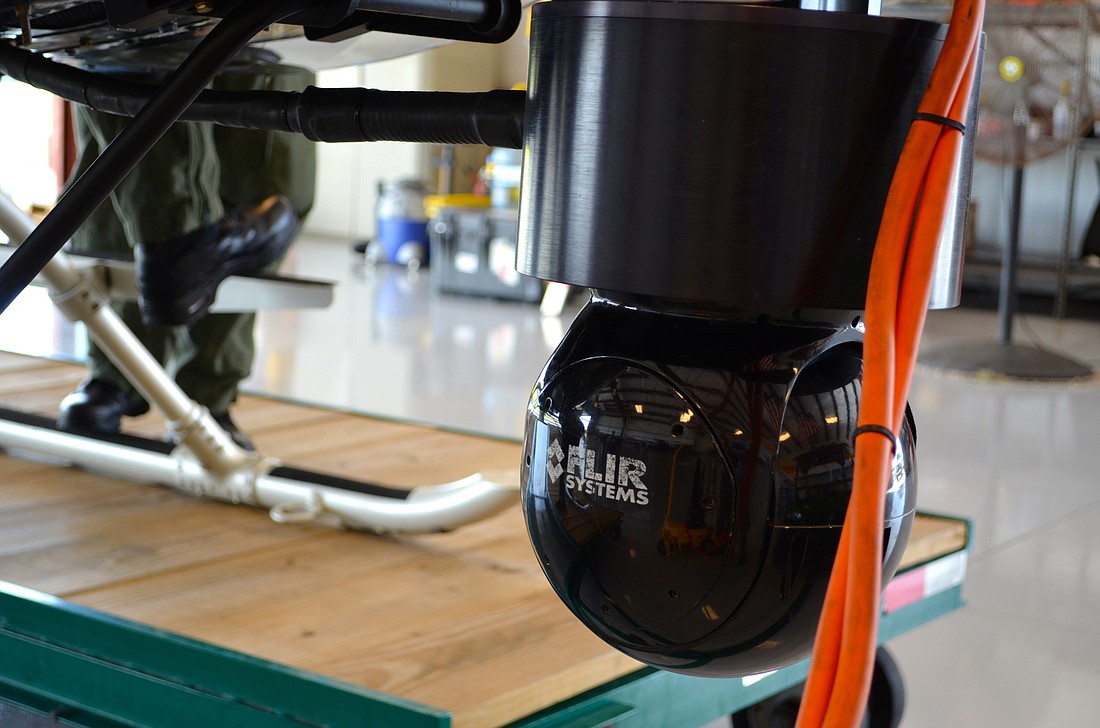- April 18, 2024
-
-
Loading

Loading

It was a normal night for Sarasota Sheriff deputies/pilots David Bouffard and Brent Wineka. The Sheriff’s Aviation Unit pilots were relaxing between flights Nov. 6, at Venice Airport, when dispatch radioed that a jewelry store had been robbed and the suspects were on the run.
Bouffard and Wineka, wearing military-green flight suits, donned their helmets (Wineka’s had a black U.S. flag on the back) and loaded into the 2005 Bell 407 helicopter. Preflight checks were done in an instant.
Bouffard, with more than 6,000 hours of flight time under his belt, made every movement in the cockpit from muscle memory, each action an automatic response to the one before. Preflight checks complete, the deputies/pilots lowered the night-vision goggles resting on their helmets to their eyes, transforming the darkness of night into flat green images. They lifted off and headed to the action.
En route, the pilots ran checks on the tool of their trade — a high-tech infrared camera, known as FLIR, which hung off the front nose of the helicopter. The camera creates images based on radiated heat and differences in temperature. Humans appear as glowing white blobs in the black-and-white images displayed on the screens in the cockpit. The camera is operated with a special controller located in the front right seat, where Wineka sits. Boston law enforcement used a similar camera to find marathon bombing suspect Dzhokhar Tsarnaev in April, and the technology is employeed in combat operations in Afghanistan.
“Being able to see at night is huge,” Bouffard said. “Criminals have nowhere to hide.”
Although the camera is a tool to track suspects and vehicles, Sheriff’s Aviation Unit pilots have also used the infrared sensor to search for lost children and walkaways from assisted-living facilities; hunt poachers in Myakka; and assist search-and-rescue operations.
“The more value we have, the better,” said Deputy Steve Boone, chief pilot for the Sheriff’s Aviation Unit. “I haven’t come across a situation in which we couldn’t use the FLIR, or it wasn’t useful.”
A deputy radioed that he had spotted a rental car with tinted windows, a telltale sign for a getaway car, and was going to check it out. Thirty seconds later, the driver hit the gas and the chase began. Bouffard and Wineka, using the call sign Air-1, were already overhead and immediately located the suspects’ vehicle with the FLIR camera. The supervisor-in-charge radioed the pursuing deputy, ordering him to back off. With Air-1’s eyes on the fleeing suspects there was no need to endanger the public with a high-speed pursuit.
While Bouffard piloted the helicopter from the left seat, Wineka operated the sensor and visually pursued the suspects while the car was driving opposite the direction of traffic.
“One of FLIR’s biggest advantages is the ability to keep eyes on a suspect at night in a car chase,” Boone said. “We can track suspects without endangering the public.”
When the five suspects bailed from the vehicle, Wineka called out updates to deputies pursuing on foot. Bouffard, simultaneously piloting the helicopter and looking out the window with his night-vision goggles, was able to follow two suspects who splintered from the main group.
The suspects hunkered down in thick overgrowth along the edge of a lake, unaware the two pilots orbiting above were announcing their movements to every deputy in Sarasota County.
Within minutes, Bouffard and Wineka were able to talk deputies onto the suspects’ positions — all five were arrested.
“I have the best job in the department,” Bouffard said. “It takes a lot more time and manpower to catch a suspect without our help.”
For their use of the FLIR camera in the pursuit and arrest of the robbery suspects, Bouffard and Wineka took home third place from among 40 entries at the FLIR Vision Awards presented at the 2013 Airborne Law Enforcement Association conference in July.
Aviation Unit pilots used the FLIR camera, which carries a $267,000 price tag, to find 87 people in Sarasota County last year; that number comprises both missing-persons cases and arrests. The Aviation Unit’s combined day and night operations in 2012 resulted in 46 missing-person finds and 155 arrests. FLIR video footage is also admissible in court as evidence.
The Aviation Unit flies a regular schedule of day and night patrols, and its pilots are always on-call if deputies on the ground radio for help.
“If someone on the ground thinks it’s important, we go — no questions asked,” Wineka said.
As for privacy restrictions, Boone said it is legal to use the FLIR to watch private property from the air. But, he insisted the camera is incapable of looking inside structures.
The Aviation Unit includes four pilots and seven tactical flight officers (TFOs). TFOs are dedicated sensor operators serving an additional duty.
Asked if there was one thing he’d like the public to know about his job, Bouffard said, “We don’t fly over your house on purpose. I promise.”
Contact Nolan Peterson at [email protected].